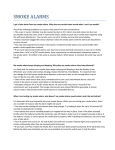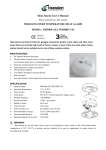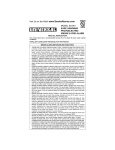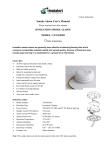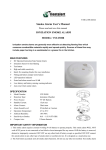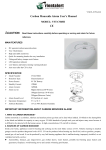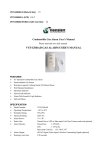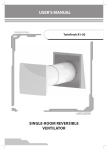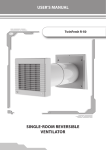Transcript
MODEL: WS588P-AF2/WS588P-V3E Photoelectric smoke alarms are generally more effective at detecting smoldering fires which smolder for hours before bursting into flame. Sources of these fires may include cigarettes burning in couches or bedding. MAIN FEATURES DC operated Wireless Photoelectric Type Smoke Alarm Photoelectric sensor for slow smoldering fires Test/Weekly button Non-radioactive technology for environmental friendly High and stable sensitivity Quick fix mounting bracket for easy installation Fitting and battery tamper-resist feature LED operation indicator Extra loud alarm sound over 85 dB Low-battery and battery missing warning indicator Auto-reset when smoke clears SPECIFICATION Model Number: Detection Type: Power Source: Working frequency: Emission distance: Standby Current: Alarm Current: Alarm Sound Level Operation Temperature: Ambient Humidity: Sensitivity to Smoke: Compact size: BEDROOM SMOKE ALARM PLACEMENT Typical single-story home Install a smoke alarm on the ceiling or wall inside each bedroom and in the hallway outside each separate sleeping area. If a bedroom area hallway is more than 30 feet long, install a smoke alarm at each end. If there is a basement: Install a smoke alarm on the basement ceiling at the bottom of the stairwell. WS588P-AF2/WS588P-V3E Photoelectric Chamber 9V DC Battery 433/868MHz >150mm(open space) 18uA max 18mA max 85 Decibels at 3 meters 5℃to 45℃ 10%-90% 3.0-6.0 %Obs /m 110mm diameter DINING ROOM LIVING ROOM BEDROOM BEDROOM HALL ACCEPTABLE HERE 0.9M(3ft) 10CM(4'') 0.9M(3ft) HORIZONTAL DISTANCE SIDEWALL 1. Near appliances or areas where normal combustion regularly occurs (kitchens, near furnaces, hot water heaters). Use specialized smoke alarm with unwanted alarm control for this areas. 2. In areas with high humidity, like bathrooms or areas near dishwashers or washing machines. Install at least 10 feet away from these areas. 3. Near air returns or heating and cooling supply vents. Installat least 3 feet away from these areas. The air could blow smoke away from the detector, interrupting its alarm. 4. In rooms where temperatures may fall below 5℃ or rise above 45℃. 5. In extremely dusty, dirty, or insect-infested areas where loose particles interfere with smoke alarm operation. WARNING: Incorrect orientation will result in a decrease in operational effectiveness. HOW TO INSTALL THIS SMOKE ALARM BEDROOM LIVING ROOM KITCHEN FINISHED BASEMENT MULTI-STORY RESIDENCE KEY: ●Minimum required smoke alarm locations ○Recommended additional smoke alarm locations △Smoke alarms with hush features recommended for additional protection IMPORTANT SMOKE ALARM PLACEMENT AND EXCEPTION INFORMATION HOW TO SET THE SMOKE ALARM INTERCONNECT WITH CONTROL PANEL 1. Find the 6-position dipswitch located on the back of each device. DIP switch function: The 1~6numeric is for coding, total 64 coding. The protection zone is composed by 2 bytes. The high byte is fixed at 170, the low byte is set by the dip switch, starting from. 000 to 063. 2. Using a pen or pencil, change the switches in each of the wireless devices. 3. The protection zone only can be read when press test button to test smoke alarm or the alarm is powered on. 4. Please refer to the manual of control panel to add the alarm. CAUTION: Due to the loudness of the alarm, always stand at an arm’s length away from the unit when testing. 1. Install a smoke alarm as close to the center of the ceiling as possible. If this is not practical, mount no closer than 4 inches from a wall or corner. Also, if local codes allow, install smokealarms on walls, between 4 and 12 inches from ceiling/wall intersections. 2. Install a minimum of two smoke alarms in every home, no matter how small the home. 3. Install a smoke alarm in each room that is divided by a partial wall (either coming down from the ceiling at least 8 inches, or coming up from the floor). 4. Install a smoke alarm in lived-in attics or attics which house electrical equipment like furnaces, air conditioners, or heaters. Problem Possible cause Solution Devices may not have power. Check that battery is properly attached to connector. 5. Using the Push-to-Test button, test the smoke alarm to verify 9V DC battery. See“TESTING THE SMOKE ALARM” 6. Reattach the smoke alarm to the mounting plate by turning the smoke alarm clockwise until it snaps into place. Smoke alarm beeps with the red LED flash every 45S Low-battery 7. Test the smoke alarm. See “TESTING THE SMOKE ALARM” Smoke alarm beeps every 45S The smoke alarm has reached its end Replace the smoke alarm with a new one. but the red LED does not of life. flash CLEANING Clean the smoke alarm at least once a month to remove dust, dirt, or debris. Using the soft brush or wand attachment of a vacuum cleaner, vacuum all sides and cover of smoke alarm. Be sure all the vents are free of debris. If necessary, use a damp cloth to clean smoke alarm cover. IMPORTANT: Do not attempt to remove the cover to clean inside the smoke alarm. This will void your warranty. TESTING THE SMOKE ALARM PRACTICE FIRE SAFETY Test Button TEST ALL SMOKE ALARMS WEEKLY BY PERFORMING THE FOLLOWING STEPS: 1. Firmly push the TEST button or use the remote testing function, the smoke alarm will sound a loud beep. The alarm will stop sounding after releasing the TEST button. 2. If smoke alarm does not sound, please retest the smoke alarm. DANGER: If the alarm sounds, and smoke alarm is not being tested, the smoke alarm is sensing smoke. THE SOUND OF THE ALARM HORN REQUIRES YOUR IMMEDIATE ATTENTION AND ACTION. MAINTENANCE AND CLEANING In addition to weekly testing, this smoke alarm requires yearly battery replacement and periodic cleaning to remove dust, dirt, and debris. If the smoke alarm sounds its alarm horn, and you have not pushed the test button, it is warning of a dangerous situation. Your immediate response is necessary. To prepare for such occurrences, develop family escape plans, discuss them with all household members, and practice them regularly. 1. Expose everyone to the sound of a smoke alarm and explain what the sound means. 2. Determine two exits from each room and an escape route to the outside from each exit. 3. Teach all household members to touch the door and use an alternate exit if the door is hot. Instruct them not to open the dor if the door is hot. 4. Teach household members to crawl along the floor to stay below dangerous smoke, fumes and gases. 5. Determine a safe meeting place for all members outside the building. WHAT TO DO IN CASE OF FIRE 1. Do not panic; stay calm. 2. Leave the building as quickly as possible. Touch doors to feelif they are hot before opening them. Use an alternate exit if necessary. Crawl along the floor, and do not stop to collect anything. 3. Meet at a pre-arranged meeting place outside the building. 4. Call the fire department from outside the building. 5. Do not go back inside a burning building. Wait for the fire department to arrive. These guidelines will assist you in the event of a fire. However, to reduce the chance that fires will start, practice fire saftety rules and prevent hazardous situations. BATTERY REPLACEMENT Replace battery at least once a year or immediately when the low battery signal sounds every 45S. Batteries should be replaced regularly as necessary. WARNING: Do not use any other type of battery, except as specified in this manual. Do not use rechargeable may apply. 1. From back of smoke alarm, remove the mounting plate by turning it counterclockwise. (To later engage tamper-resist feature, twist out and set aside one of the pins molded into plate. Both pins are exactly the same.) 2. Secure plate to ceiling or wall with mounting screws.. 3. Lift open battery pocket door. 4. Connect new 9-volt battery to battery connector inside battery pocket. Be sure battery is securely connected. Red LED may blink briefly when battery is installed. 5. Close battery pocket door, snapping it into place. 6. Position smoke alarm to mounting plate and turn clockwise to lock into place. To engage tamper-resist feature, insert pin into notch on edge of smoke alarm after alarm is properly positioned in base. 7. Push test button to test smoke alarm. See TESTING THE SMOKE ALARM. Not all of the alarms/accessories connect with the control panel. The unit requires one standard 9V battery. The following batteries are acceptable as replacements: Golden Power#6F22, Megaton #6F22; New Leader #6F22; Gold Peak #1604; Eveready #522, #1222. Golden Power G6F22; Golden Power GL6F22A Once the smoke alarm has been installed A RED indicator light (LED) should flash approximately once a minute to indicate the battery is healthy and the unit is operating properly. If smoke is detected, the unit will emit a load pulsating alarm and a RED indicator light (LED) will be flashing quickly until the air is clear. WARNING: Smoke alarm installation must be in accordance with the requirements of any national and local codes that 1. Turn smoke alarm counterclockwise to detach it from the mounting plate. 2. Gently pull down smoke alarm. 3. Remove battery from the compartment. 4. Insert a new 9-volt battery to connector. NOTE POLARITY OF CONNECTIONS. Ensure the metal tab is fully depressed when the battery has been fitted. CHOOSING A REPLACEMENT BATTERY: OPERATING YOUR SMOKE ALARM CAUTION: Explosion could happen if battery is incorrectly replaced. BEST HERE NEVER HERE SINGLE-STORY RESIDENCE,APARTMENT, MOBILE HOME Install a smoke alarm on the ceiling or wall inside each bedroom and in the hallway outside each separate sleeping area. If a bedroom area hallway is more than 30 feet long, install a smoke alarm at each end. Please install a smoke alarm on the top of a first-to-second floor stairwell. 1. This smoke alarm requires constant working 9-volt battery tooperate properly. This smoke alarm WILL NOT work if the battery is removed, drained or improperly connected. DO NOT use any other kind of battery except as specified. The Test button accurately tests all smoke alarm functions. Do not use any other test method. Test smoke alarm weekly to ensure proper operation. 2. DO NOT remove or disconnect battery to quiet unwanted alarms. This will remove your protection. Open windows or fan the air around smoke alarm to silence it batteries. ANYWHERE IN THIS AREA Typical Multi-story or split level home IMPORTANT SAFETY INFORMATION 1. Test each smoke alarm to be sure it is installed correctly and operating properly. 2. The push-to-test button accurately tests functions. Do not use an open flame to test this smoke alarm. You may ignite and damage the smoke alarm or your home. 3. Test smoke alarms weekly and upon returning from vacation or when no one has been in the household for several days. 4. Stand at arm’s length from the smoke alarm when testing. KITCHEN MINIMUM MINIMUM WIRELESS PHOTOELECTRIC SMOKE ALARM 10CM(4'') CEILING 30CM(12'') Please read and save this manual DO NOT INSTALL SMOKE ALARMS MAXIMUM Smoke Alarm User’s Manual 3. For installation, observe all local and national electrical building codes. 4. This smoke alarm is designed to be used inside a singleroom only. In multi-room buildings, each individual living unit should have its own smoke alarms. Do not install in non-residential buildings. And this smoke alarm is not a substitute for a complete alarm system. 5. Smoke may not reach the smoke alarm for many reasons. For example, if a fire starts in a remote part of the home, on another level, in a chimney, wall, roof, or on the other side of a closed door, smoke may not reach the smoke alarm in time to alert household members. A smoke alarm will not promptly detect a fire except in the area or room in which it is installed. 6. Smoke alarms may not alert every household member every time. The alarm sound is loud in order to alert individuals of a potential danger. However, there may be limiting circumstanceswhere a household member may not hear the alarm (i.e. outdoor or indoor noise, sound sleepers, drug or alcohol usage, the hard of hearing, etc.). If you suspect that this smoke alarm may not alert a household member, install and maintain specialty smoke alarms. Household me mber must hear the alarm’s warning sound and quickly respond to it to reduce the risk of damage, injury, or death that may result from fire. If a household member is hearing impaired, install special smoke alarms with lights or vibrating devices to alert occupants. 7. Smoke alarms can only sound their alarms when they detect smoke. Smoke alarms detect combustion particles in the air. They do not sense heat, flame, or gas. This smoke alarm is designed to give audible warning of a developing fire. However, many fires are fast-burning, explosive, or intentional. Others are caused by carelessness or safety hazards. Smoke may not reach the smoke alarm QUICKLY ENOUGH to ensure safe escape. 8. Smoke alarms have limitations. This smoke alarm is not foolproof and is not warranted to protect lives or property from fire. Smoke alarms are not a substitute for insurance. Homeowners and renters are responsible for insuring their lives and property. In addition, it is possible for the smoke alarm to fail at any time. For this reason, you must test the smoke alarm weekly and replace every 10 years. Note: For best protection, we recommend that you install a smoke alarm in every room. TROUBLESHOOTING WARNING: DO NOT disconnect battery to quiet an unwanted alarm. This will remove your protection. Fan the air or open a window to remove smoke or dust. The smoke alarm is far away from the Install the smoke alarm close to the control panel. control panel. Manufacturer: Xiamen Vs-Top Electronics Co., Ltd. 6th floor, Jinzhongda Park, No-666 Yangguang Road, Xinyang Industrial District, Haicang ,Xiamen, China. Tel:0086-592-6017700 E-mail: [email protected] Website: www.orientalert.com Replace battery. See battery replacement in the maintenance and cleaning section.





